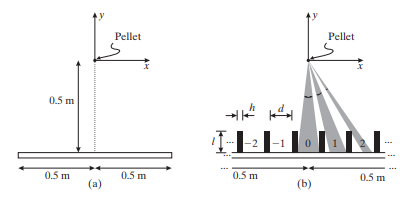A small pellet is located at the origin and filled with a radiotracer, as shown in Figure P8.9(a). Assume a two-dimensional scenario in which the pellet emits gamma rays only in the x-y plane and the radioactivity is equal to A = 0.027 mCi.
(a) What is the average rate of photons hitting the detector (1-D Anger camera)?
Assume the detector is made of NaI(Tl) (μ = 0.644 cm−1) and its thickness is b = 2.5 cm.
(b) What is the detector efficiency at the center of the detector?
(c) If the Anger camera is rotated stepwise around the origin and requires 2 × 105 detected counts at each orientation, how many orientations can be captured in 10 seconds? (Ignore rotation time.) A parallel hole collimator with septal thickness h = 5 mm, septal height l = 12 cm, and hole diameter d = 5 mm, is mounted on the camera, as shown in Figure P8.9(b).

Figure P8.9 See Problem 8.20.
(d) What is the collimator resolution Rc at the range of the pellet?
(e) Assume that there is no Compton scattering and that the lead septa always absorb gamma rays incident upon them. Find the rate of photons hitting the detector in the three central holes. Plot this as a function of hole number for n = −1, 0, +1.
(f) What is the (approximate) resolution Rˆc that you would deduce from your result in part (e)? Compare with Rc and speculate on any difference you may observe.

